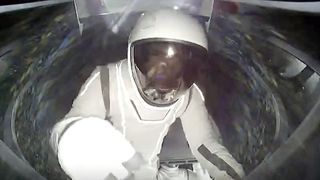Two private astronauts conducting the first commercial spacewalk did not so much float out of their spacecraft as they did “stand up.”
Polaris Dawn crewmates Jared Isaacman and Sarah Gillis took turns emerging from the upper hatch of SpaceX’s Dragon spacecraft “Resilience” on Thursday (Sept. 12). It was the first time that non-government astronauts have left the protective confines of their vehicle for the vacuum of space. It was also the 20th stand-up extravehicular activity (SEVA) in history.
“I think back at home, we all have a lot of work to do, but from here, Earth sure looks like a perfect world,” said Isaacman as he cleared the Dragon’s hatch and saw the lit planet before heading into a night pass.
Isaacman, the billionaire entrepreneur who funded this five-day flight and two more Polaris Program missions to follow, was the first to pop his helmet-covered head out from where a docking ring would normally be if the Dragon was connecting with the International Space Station. Instead, SpaceX equipped the capsule with the “Skywalker,” a set of rails and foot holds that was specifically designed to keep the tethered and umbilical-connected astronauts in contact with the vehicle.
With the nose of the Dragon pointed towards Earth and its deployed nose cap acting as a shield less any micrometeoroid debris come zipping along, Isaacman and Gillis each took about 10 minutes to put SpaceX’s EVA suit through its paces.
“It includes all sorts of technology, including a heads-up display, a helmet camera [and] an entirely new architecture for joint mobility,” said Polaris Dawn crewmate Anna Menon of SpaceX’s new EVA suits during a pre-fight press conference. “There is thermal insulation throughout the suit, including a copper and indium tin oxide visor that provides both thermal protection and solar protection. And then throughout, there is all types of redundancy, both in the oxygen supply feed to the suit and all of the valves and all of the seals across the suit.”
Inside Resilience, Scott “Kidd” Poteet and Menon also wore EVA spacesuits, as Dragon’s lack of an airlock meant that the entire cabin had to be depressurized for their crewmates’ spacewalk. The same approach was first used by NASA for its Gemini spacecraft in the mid-1960s, which is also when a…
Click Here to Read the Full Original Article at Space…

